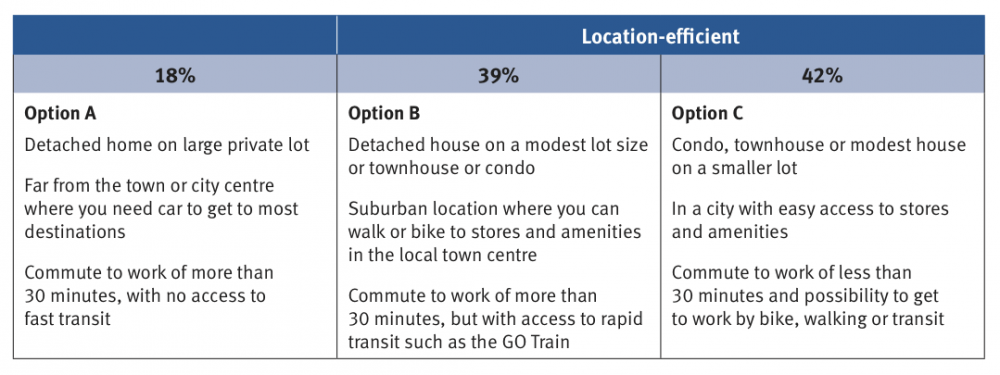I consider myself “location lucky.” I live in a leafy downtown Toronto neighbourhood where I can cycle or walk to work and other daily destinations. Four rapid transit lines are just steps away from my home.
Being single, it’s feasible for me to live in a one-bedroom condo. But many of my friends with kids cannot afford a family-sized house downtown or somewhere conveniently located. Like so many others, they head to the distant, car-dependent suburbs in pursuit of an affordable home.
Where we live is as important as what we live in
Not surprisingly, a survey released this week by RBC and the Pembina Institute concludes that homebuyers in the Greater Toronto Area (GTA) are looking for affordable alternatives to living in the sprawling suburbs.
Although most respondents identified a detached single-family home as a top consideration when choosing where to live, 81 per cent of residents surveyed in the GTA would give up a large house and yard for a townhouse, condo or small home on a modest lot with walkable access to amenities, rapid transit, and the option to spend less time behind the wheel.
There is a clear desire for smaller but family-friendly homes that are close to where people need to go everyday. But these options are currently beyond most homebuyers’ budgets. Nearly 80 per cent of GTA residents indicated that housing cost influences where they live.
“Driven” to the fringes
 Developers continue to build in sprawling greenfields because it is often cheaper and easier than building developments in walkable, transit-oriented neighbourhoods. Lack of supply means homebuyers are priced out of these locations and are literally “driven” to the urban and suburban fringes, where long and stressful auto commutes are required.
Developers continue to build in sprawling greenfields because it is often cheaper and easier than building developments in walkable, transit-oriented neighbourhoods. Lack of supply means homebuyers are priced out of these locations and are literally “driven” to the urban and suburban fringes, where long and stressful auto commutes are required.
Even worse, transportation and other costs can cancel out lower prices for remote homes. Homeowners may not be aware of how their monthly expenses are affected not just what kind of home they live in but also by wherethey live. The Pembina Institute conducted a very recent case study comparing housing and transportation costs in seven different locations across the GTA. We found that car ownership has a significant impact on monthly costs. For this case study, each vehicle removed from a household budget enabled approximately $200,000 more to be carried on a 25-year mortgage.
Finding ways to build what homebuyers want
It can be challenging for homebuyers to finance more “location-efficient” homes, even if a higher purchase price is outweighed by decreased transportation costs. Current mortgage assessment practice accounts for debt and costs associated with servicing that debt, such as car payments, but does not include the costs associated with vehicle use such as gas, insurance, parking and maintenance. So buyers are rewarded initially for purchasing a less costly home that is remote, even though it will incur high transportation costs over time.
What is location-efficient development?
- Convenient distance from workplaces, amenities, stores and urban hubs
- Access to rapid transit
- Short commute times
- Realistic opportunities to use transit, walk or cycle to where you go, work and play
Changing mortgage assessment is one way to correct these location-cost distortions. This week, a concurrent study was released by the Cool Communities Group that identifies five policy tools that could be put in place now to create more affordable choices for homebuyers to live in walkable, transit-oriented neighbourhoods. The group, which includes the Pembina Institute, calls this “location-efficient” development — essentially, the type of development that enables people to live where they go, work and play. The group conducted detailed consultations with stakeholders to determine the best policy options that are effective and politically feasible in the Greater Golden Horseshoe region. (see below)
5 tools to encourage location-efficient development in Ontario
- Developing a location cost calculator to inform and educate homebuyers about the cost of their location choices
- Changing development charges so that location-efficient development costs less, while removing the subsidy currently going to expensive-to-service sprawl.
- Taxing surface parking at higher rates to reduce the space wasted on, and implicit subsidies for, surface parking
- Removing or reducing minimum parking requirements for new developments, allowing developers and municipalities to provide parking according to the market and maximizing land efficiencies.
- Under the Metrolinx Act, making transit funding contingent on meeting location-efficient development criteria near mobility hubs and transit lines.
Location efficiency is not limited to downtown living
 Location efficiency can occur outside of the urban Toronto core. For example, as Markham grows commercially and residentially, some of its neighbourhoods around employment hubs are becoming more walkable, allowing people to live and work in the same community. Other neighbourhoods are accessible by rapid transit, allowing commuters to efficiently move from home to work without getting stuck in traffic. Central Aurora is a prime example, with a GO train line for commuting to jobs located in Toronto and a walkable town centre.
Location efficiency can occur outside of the urban Toronto core. For example, as Markham grows commercially and residentially, some of its neighbourhoods around employment hubs are becoming more walkable, allowing people to live and work in the same community. Other neighbourhoods are accessible by rapid transit, allowing commuters to efficiently move from home to work without getting stuck in traffic. Central Aurora is a prime example, with a GO train line for commuting to jobs located in Toronto and a walkable town centre.
In fact, the Pembina–RBC survey found that most people prefer location-efficient homes, whether in suburbs or city; see the figure below.
Figure 1. Homebuyer preferences for home location, with home cost held equal. From RBC-Pembina Home Location Study.
In a region with a growing population and a competitive housing market, finding the right place to live is always a challenge. But if the province and municipal governments begin putting in place some of these solutions proposed by the Cool Communities group, more of us can be “location lucky,” with lower monthly costs, less time behind the wheel, and more time to enjoy the communities we live in.
Cherise Burda was Ontario director at the Pembina Institute until 2015.




